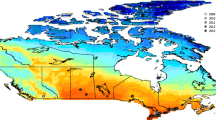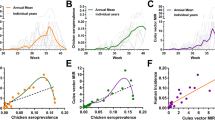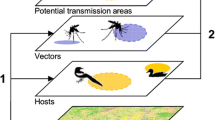Abstract
We assessed the changes in abundance of American crows in the northeastern U.S. following the arrival of West Nile virus (WNV), with two aims. First, we determined the impact and spatial extent of the initial epizootic that began in New York City. Second, we examined whether two existing surveillance programs monitoring for WNV (data from 2000 New York State dead bird testing, and 2000 mosquito testing) accurately predicted the observed impact of the disease on crow populations as measured using data from the North American Christmas Bird Count. The rationale for this second aim was that the two WNV surveys were new and with unknown biases and sensitivity, while the Christmas Bird Count has existed for decades, providing monitoring before the arrival of WNV in North America and a long time series of data useful in gauging sensitivity. As a result, the Christmas Bird Count represents a good benchmark against which to compare the two new surveillance programs. Consistency among these three sources of information was low, suggesting that while dead bird and mosquito surveys can currently indicate the later stages of severe outbreaks, the ability to consistently detect early stages of outbreaks is questionable.


Similar content being viewed by others
References
KA Bernard JG Maffei SA Jones EB Kauffman GD Ebel A Dupuis SuffixII et al. (2001) ArticleTitleWest Nile virus infection in birds and mosquitoes, New York State, 2000 Emerging Infectious Diseases 7 679–685
KP Burnham DR Anderson (2002) Model Selection and Multi-model Inference Springer-Verlag Heidelberg
GS Butcher MR Fuller LS McAllister PH Geissler (1990) ArticleTitleAn evaluation of the Christmas Bird Count for monitoring population trends of selected species Wildlife Society Bulletin 18 129–134
C Caffrey CC Peterson (2003) ArticleTitleWest Nile virus may not be a conservation issue in the northeastern United States American Birds (103rd Christmas Bird Count) . 14–21
B Durnad V Chevalier R Pouillot J Labie I Marendat B Murgue et al. (2002) ArticleTitleWest Nile virus outbreak in horses, southern France, 2000: results of a serosurvey Emerging Infectious Diseases 8 777–782
M Eidson N Komar F Sorhage et al. (2001a) ArticleTitleCrow deaths as a sentinel survillance system for West Nile virus in the Northeastern United States, 1999 Emerging Infectious Diseases 7 615–620
M Eidson L Kramer W Stone Y Hagiwara K Schmit InstitutionalAuthorNameThe New York State West Nile Virus Avian Surveillance Team (2001b) ArticleTitleDead bird surveillance as an early warning system for West Nile virus Emerging Infectious Diseases 7 631–635
SC Guptill KG Julian GL Campbell SD Price AA Marfin (2003) ArticleTitleEarly-season avian deaths from West Nile virus as warnings of human infection Emerging Infectious Diseases 9 483–484
WA Link JRJ Sauer (1999) ArticleTitleControlling for varying effort in count surveys—an analysis of Christmas Bird Count data Agricultural Biological and Environmental Statistics 4 116–125
RC Littell GA Milliken WW Stroup RD Wolfinger (1996) SAS System for Mixed Models SAS Institute Inc. Cary, NC
RG McLean SR Ubico DE Docherty WR Hansen L Sileo TS McNamara (2001) ArticleTitleWest Nile virus transmission and ecology in birds Annals of the New York Academy of Sciences 951 54–57
F Mostashari M Kulldorff JJ Hartman JR Miller V Kulasekera (2003) ArticleTitleDead bird clusters as an early warning system for West Nile virus activity Emerging Infectious Diseases 9 641–646
B Murgue MH Triki V Deubel AHG Zeller (2001) ArticleTitleWest Nile in the Mediterranean Basin: 1950–2000 Annals of the New York Academy of Sciences 951 117–126
Reed L, Crans WJ, Komar N, Panella NA, McLean RG, Creekmore T (2001) West Nile virus seroprevalence in crows. In: Proceedings of the Annual Conference of the American Mosquito Control Association; February 18–22, 2001, Dallas; American Mosquito Control Association, New Brunswick, NJ
Sauer JRJ, Hines JE, Thomas I, Fallon J, Gough G (2000) The North American Breeding Bird Survey. Results and Analysis 1966–1999, Version 98.1. Patuxent Wildlife Research Center, Laurel, Maryland [cited October 4, 2002]. Available: http://www.mbr-pwrc.usgs.gov/bbs/bbs.html
J Shaman JF Day M Stieglitz (2002) ArticleTitleDrought-induced amplification of Saint Louis encephalitis virus, Florida Emerging Infectious Diseases 8 575–580
RM Taylor TH Work HS Hurlbut F Rizk (1956) ArticleTitleA study of the ecology of West Nile virus in Egypt American Journal of Tropical Medicine and Hygiene 5 579–620
U.S. Census Bureau (2000) United States Census 2000 [cited August 20, 2002]. Available: http://www.census.gov/main/www/cen2000.html
Acknowledgments
The data needed to conduct this study could not have been gathered without the dedicated volunteers who annually conduct the Christmas Bird Count, which is coordinated by the National Audubon Society. IT staff at the Cornell Laboratory of Ornithology maintained the database. Monitoring of dead birds also required the participation of the general public. All West Nile virus surveillance data were gathered by the New York State West Nile Virus Surveillance Team.
Author information
Authors and Affiliations
Corresponding author
Rights and permissions
About this article
Cite this article
Hochachka, W.M., Dhondt, A.A., McGowan, K.J. et al. Impact of West Nile Virus on American Crows in the Northeastern United States, and Its Relevance to Existing Monitoring Programs. EcoHealth 1, 60–68 (2004). https://doi.org/10.1007/s10393-004-0015-8
Published:
Issue Date:
DOI: https://doi.org/10.1007/s10393-004-0015-8




